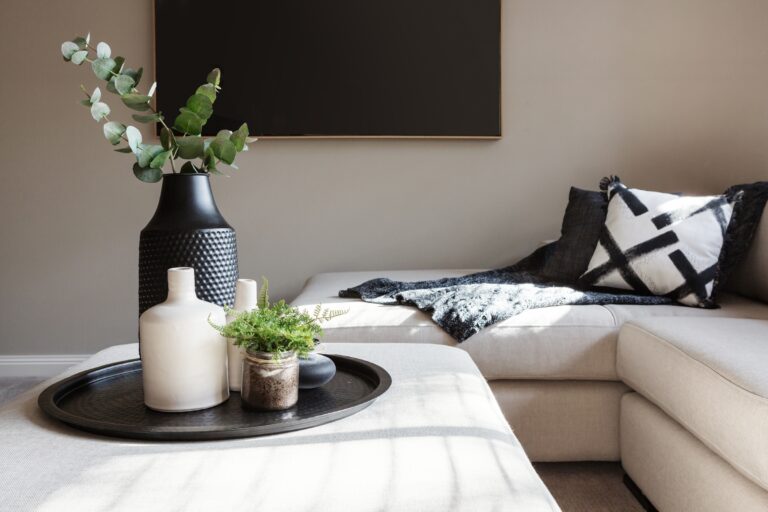Whether you’re about to start or are already running an interior design small business, you know one thing: being at the helm of an interior design business requires so much more than a passion for creating beautiful spaces. If you want to succeed, you’ll need to prioritize administrative tasks, marketing, project management, and more.
By implementing these 10 tips, you’ll be well on your way toward not only getting your interior design business off the ground—but helping it soar.
Table of Contents
#1: Identify your niche
Identifying your niche is a crucial first step in starting an interior design business. The interior design industry is broad, and trying to appeal to everyone can dilute your brand and make it harder to stand out. To identify your nice, consider the following:
- What are you passionate about?
- What is the unique value proposition you bring to the market?
- What is your zone of genius?
Your niche may include a specific style, like boho, minimalist, or coastal. It could also be something like creating eco-friendly spaces or family-friendly designs. Research your target market to understand their needs and preferences. By focusing on a specific niche, you can tailor your services, marketing, and brand identity to attract clients looking for exactly what you offer, setting yourself apart in a competitive market.
#2: Build strategic relationships
In-person networking is critical to building the right relationships. When possible, attend the same events as your ideal clients. For example, if you’re seeking high-ticket clients in your city, research local charity galas. When you connect with a prospect, sending a follow-up note on branded stationery is a nice touch.
Speak to the sales managers in your local tile and flooring shop, appliance center, and even the lumberyard. The more positive connections you make, the more people will hire and/or refer you.
Also take advantage of online networking. Join local and industry-specific Facebook groups, and don’t hesitate to be helpful, sharing tips and guidance wherever it makes sense. Connect with potential industry collaborators on LinkedIn. Each of these steps will increase your brand visibility while building strategic relationships.
#3: Build a strong social media presence
Sharing great content on Facebook and Instagram is a great way to build a strong online presence. The most important rule? Be authentic. Post high quality images of your work, as well as behind-the-scenes shots and peeks into your personality. Grab our free Instagram guide for tips on how to leverage your Instagram account to grow your business. If you haven’t yet built up a portfolio, you can showcase your style using moodboards and renderings.
The more high-quality content you share on social media, the stronger your brand presence will be. And the more you pop up in peoples’ feeds, the more they’ll think of using you for their interior design needs.
#4: Create a website with SEO best practices
You don’t need a fancy or highly technical website, but you do need an online home where clients can learn more about your services, your work, and how to take the first step toward working with you. Your website should reflect your brand and aesthetic, and it needs to ensure you’re searchable so potential clients can find you.
Start by creating a Google My Business account to show up locally. Add a detailed list of your services and highlight your niche in your business description. Add photos of past work, moodboards, or renderings to showcase your abilities.
Download our free SEO Guide for Interior Designers to boost your search result placement for your new site.
#5: Perfect your customer experience systems
You want your clients to feel taken care of while they work with you. The better their experience from the start, the more likely they’ll be to sign on (and come back for future projects).
Look into each of these areas and seek out ways to improve them:
- Inquiry — How soon do you respond to leads? Do they feel welcomed right away? Are they greeted with the level of professionalism you need to convey? Sales funnels can help with this phase (automatic emails with next steps sent when a new lead reaches out for the first time).
- Proposal — A great interior design proposal is essential to securing clients. Check out our guide on how to write a winning interior design proposal here.
- Onboarding — Are next steps for working together crystal clear for the client? Any confusion or disorganization can start things off on the wrong foot. Our guide to creating a welcome packet will help you streamline this process.
- Communication — How do clients contact you? How soon do you respond? How do you ensure they feel connected to their project without causing you to burn out? Being up front about how often you will communicate, and the best ways and times to reach out to you, will help.
- Delivery — Is your design delivery cohesive? Use project management software, like DesignFiles, to look pro and keep all the moving parts organized and in one place.
- Offboarding — Are you staying in touch after project completion to make sure there are no issues or follow-up questions? Make sure you sincerely thank your clients for their business and stay in touch so they remember to refer you and reach out for future projects.
#6: Collect and showcase client reviews and testimonials
Client reviews and case studies are often the first place leads look when they’re deciding whether or not they’ll use your services. Ensure you showcase your best testimonials and case studies prominently throughout your website, social media, and email marketing.
Also consider asking clients to leave feedback when you wrap up a project. Send clients a link to the site you’d like them to leave their review on (Google My Business, Facebook, Yelp, etc) to make it as easy as possible.
For tips on how to request and collect the best possible testimonials and case studies, check out this post.
#7: Charge competitive rates
It can be tempting to take lower-paying clients to add to your portfolio, but we recommend avoiding this whenever possible. You know the worth of your work, and there are clients out there that are willing and able to pay it.
If you aren’t making as much as you want to, it’s time to examine your pricing strategy. Use these 16 pricing tips to make sure you’re charging enough for your services.
Next consider other ways to boost your income. One of the easiest ways to grow your profits as an interior designer is through product markups. Remember, markups are standard practice and they’re fair for business owners and clients. Product markups compensate you for sourcing materials, furniture, and decor. They also help cover your business’s overhead, risks, and liability.
Make sure you’re finding the best deals on products so the markup feels fair on both ends (and so you can bring in more income from it). Average markup rates range from 25-40%. You can learn everything you need to know about sourcing wholesale and adding mark-ups here.
#8: Build a referral network with potential collaborators
Some of the best projects come from referrals with potential collaborators. Reach out to local architects, builders, and general contractors, all of whom are likely to seek out interior designers to team up with.
Get to know other interior designers as well, as they may be able to share work with you in the future when they’re own schedules fill up faster than they can manage.
What’s the best way to connect with other professionals? You can call or email them directly, join niche-related Facebook groups, check out local associations, or attend trade events that align with your business.
After you connect, keep in touch. The stronger your relationships become, the more likely referrals will come from them.
Want to learn more? Use our networking and referral guide to start and strengthen referral relationships as your business grows.
#9: Protect yourself legally
Contracts are an essential part of interior design small businesses. They outline the scope of work and timeline, protect your compensation, and prevent liabilities. A new contract needs to be signed for every project. You can hire attorneys to write contracts for you, purchase contracts from other interior designers online, or create your own on platforms like DesignFiles. Check out this guide to learn more about writing your own contract for e-design or full service design. Keep in mind you’ll still want to have it reviewed by an attorney to ensure it provides adequate protection.
Interior designers also need liability insurance. This protects you from being sued if a client is injured, if their home is damaged due to design errors, or if they face financial strain due to mistakes made on your end. General liability, professional liability, and workers’ compensation insurance are all beneficial for interior design small businesses.
#10: Consider outsourcing tasks as needed
If your business is growing faster than you can keep up, don’t be afraid to outsource tasks. You can start with outsourcing non-design tasks, for example, hiring a social media manager or marketing firm. You could also hire an administrative assistant to help with onboarding, email scheduling, calendar management, and inquiries.
If you need support on the design front, consider working with a freelance design assistant. These individuals can help you with anything from sourcing to mood boards, with their work being left to your discretion.
Frequently asked questions
First, decide what type of work you’d like to do. Narrow down your target audience, skillset, and past experiences. Next, put together a portfolio. Your initial images could be from a client project, work you’ve done for a close friend or family member, or even a project you’ve taken on in your own home.
Once you have high-quality images available, you can start to market your business. Tell the people in your life about your business, advertise locally, and start sharing on social media sites.
While you look for your first clients, work on the back-end items. Solidify your contracts and customer experience systems, decide how you want to source products (if you’re a full-service designer), look into online tools for client management and project management, and build a website and email list.
Be sure to follow other designers and platforms like DesignFiles for more advice as you start your business as well.
To grow your business, you need more leads. You need those leads to convert. And you need your clients to be exceptionally happy with your work.
To make this happen, focus on advertising, marketing, and producing quality designs. Share images of past projects and ask for client testimonials. Simplify back-end tasks with an interior design business software so you can focus more on producing wow-worthy work. Check out this guide to get more leads coming into your funnel as well.
Common challenges include meeting client expectations, time and budget constraints, managing business costs, charging appropriately, keeping up on back-end tasks, and balancing trends with timeless designs. Each of these challenges can be worked through with thoughtful planning in all project stages (and in the behind-the-scenes work, too).
Ready to launch your interior design business? Start on a strong foundation. Learn more about DesignFiles, the top-rated platform for solo and small interior design firms.


